Iron Molybdate Fe2(MoO4)3 Nanoparticles: Efficient Sorbent for Methylene Blue Dye Removal from Aqueous Solutions
Abstract
1. Introduction
2. Results and Discussion
2.1. MB Removal
2.1.1. pH Effect
2.1.2. Adsorbent Dose Effect
2.1.3. Initial Dye Concentration and Contact Time Effect
2.1.4. Temperature Effect
2.2. Kinetic Study
2.3. Adsorption Isotherms
2.4. Regeneration and Characterization of the Fe2(MoO4)3 Nanosorbent
2.4.1. Regeneration Efficiency
2.4.2. Fourier-Transform Infrared Spectroscopy
2.5. MB Removal Mechanism
3. Experimental
3.1. Iron Molybdate Nanosorbent Preparation
3.2. Adsorption Investigations
3.3. Method for Adsorbent Regeneration
3.4. Characterization
4. Conclusions
Author Contributions
Funding
Conflicts of Interest
References
- Sakamoto, M.; Tofayel, A.; Begum, S.; Huq, H. Water Pollution and the Textile Industry in Bangladesh: Flawed Corporate Practices or Restrictive Opportunities? Sustainability 2019, 11, 1951. [Google Scholar] [CrossRef]
- Ulson de Souza, S.M.A.G.; Forgiarini, E.; Ulson de Souza, A.A. Toxicity of textile dyes and their degradation by the enzyme horseradish peroxidase (HRP). J. Hazard Mater. 2007, 147, 1073–1078. [Google Scholar] [CrossRef] [PubMed]
- Wu, M.; Yu, W.; Qu, J.; Gregory, J. The variation of flocs activity during floc breakage and aging, adsorbing phosphate, humic acid and clay particles. Water Res. 2019, 155, 131–141. [Google Scholar] [CrossRef] [PubMed]
- Greluk, M.; Hubicki, Z. Effect of basicity of anion exchangers and number and positions of sulfonic groups of acid dyes on dyes adsorption on macroporous anion exchangers with styrenic polymer matrix. Chem. Eng. J. 2013, 215–216, 731–739. [Google Scholar] [CrossRef]
- Piai, L.; Blokland, M.; van der Wal, A.; Langenhoff, A. Biodegradation and adsorption of micropollutants by biological activated carbon from a drinking water production plant. J. Hazard. Mater. 2020, 388, 122028. [Google Scholar] [CrossRef]
- Cornelia, P.; Oana, P.; Robert, I.; Simona, G.M. Effective removal of methylene blue from aqueous solution using a new magnetic iron oxide nanosorbent prepared by combustion synthesis. Clean Technol. Environ. Policy 2016, 18, 705–715. [Google Scholar]
- Liu, T.; Zhou, H.; Graham, N.; Yu, W.; Sun, K. 2D kaolin ultrafiltration membrane with ultrahigh flux for water purification. Water Res. 2019, 156, 425–433. [Google Scholar] [CrossRef] [PubMed]
- Forgacs, E.; Cserhati, T.; Oros, G. Removal of synthetic dyes from wastewaters: A review. Environ. Int. 2004, 30, 953–971. [Google Scholar] [CrossRef] [PubMed]
- Jiang, R.; Lu, G.; Yan, Z.; Wu, D.; Zhou, R.; Bao, X. Insights into a CQD-SnNb2O6/BiOCl Z-scheme system for the degradation of benzocaine: Influence factors, intermediate toxicity and photocatalytic mechanism. Chem. Eng. J. 2019, 374, 79–90. [Google Scholar] [CrossRef]
- Miyah, Y.; Lahrichi, A.; Idrissi, M.; Khalil, A.; Zerrouq, F. Adsorption of methylene blue dye from aqueous solutions onto walnut shells powder: Equilibrium and kinetic studies. Surf. Interface 2018, 11, 74–81. [Google Scholar] [CrossRef]
- Kang, S.; Zhao, Y.; Wang, W.; Zhang, T.; Chen, T.; Yi, H.; Rao, F.; Song, S. Removal of methylene blue from water with montmorillonite nanosheets/chitosan hydrogels as adsorbent. Appl. Surf. Sci. 2018, 448, 203–211. [Google Scholar] [CrossRef]
- Chen, Y.H. Synthesis, characterization and dye adsorption of ilmenite nanoparticles. J. Non-Cryst. Solids 2011, 357, 136–139. [Google Scholar] [CrossRef]
- Ozdemir, U.; Ozbay, I.; Ozbay, B.; Veli, S. Application of economical models for dye removal from aqueous solutions: Cash flow, cost–benefit and alternative selection methods. Clean Technol. Environ. Policy 2014, 16, 423–429. [Google Scholar] [CrossRef]
- Chen, X.; Liu, L.; Luo, Z.; Shen, J.; Ni, Q.; Yao, J. Facile preparation of a cellulose-based bioadsorbent modified by hPEI in heterogeneous system for high-efficiency removal of multiple types of dyes. React. Funct. Polym. 2018, 125, 77–83. [Google Scholar] [CrossRef]
- Rezk, M.Y.; Zeitoun, M.; El-Shazly, A.N.; Omar, M.M.; Allam, N.K. Robust photoactive nanoadsorbents with antibacterial activity for the removal of dyes. J. Hazard. Mater. 2019, 378, 120679. [Google Scholar] [CrossRef] [PubMed]
- Low, S.K.; Tan, M.C. Dye adsorption characteristic of ultrasound pre-treated pomelo peel. J. Environ. Chem. Eng. 2018, 6, 3502–3509. [Google Scholar] [CrossRef]
- Rakass, S.; Mohmoud, A.; Oudghiri-Hassani, H.; Abboudi, M.; Kooli, F.; Al Wadaani, F. Modified Nigella Sativa Seeds as a Novel Efficient Natural Adsorbent for Removal of Methylene Blue Dye. Molecules 2018, 23, 1950. [Google Scholar] [CrossRef]
- Kittappa, S.; Jais, F.M.; Ramalingam, M.; Ibrahim, S. Functionalized magnetic mesoporous palm shell activated carbon for enhanced removal of azo dyes. J. Environ. Chem. Eng. 2020, 8, 104081. [Google Scholar] [CrossRef]
- Widiyastuti, W.; Rois, M.F.; Suari, N.M.I.P.; Setyawan, H. Activated carbon nanofibers derived from coconut shell charcoal for dye removal application. Adv. Powder Technol. 2020, 31, 3267–3273. [Google Scholar] [CrossRef]
- Madrakian, T.; Afkhami, A.; Ahmadi, M.; Bagheri, H. Removal of some cationic dyes from aqueous solutions using magnetic modified multi-walled carbon nanotubes. J. Hazard Mater. 2011, 196, 109–114. [Google Scholar] [CrossRef]
- Oyewo, O.A.; Elemike, E.E.; Onwudiwe, D.C.; Onyango, M.S. Metal oxide-cellulose nanocomposites for the removal of toxic metals and dyes from wastewater. Int. J. Biol. Macromol. 2020, 164, 2477–2496. [Google Scholar] [CrossRef]
- Oudghiri-Hassani, H. Synthesis, characterization and catalytic performance of iron molybdate Fe2(MoO4)3 nanoparticles. Catal. Commun. 2015, 60, 19–22. [Google Scholar] [CrossRef]
- Oudghiri-Hassani, H.; Rakass, S.; Abboudi, M.; Mohmoud, A.; Al Wadaani, F. Preparation and Characterization of α-Zinc Molybdate Catalyst: Efficient Sorbent for Methylene Blue and Reduction of 3-Nitrophenol. Molecules 2018, 23, 1462. [Google Scholar] [CrossRef] [PubMed]
- Al-Wadaani, F.; Omer, A.; Abboudi, M.; Oudghiri-Hassani, H.; Rakass, S.; Messali, M.; Benaissa, M. High Catalytic Efficiency of Nanostructured β-CoMoO4 in the Reduction of the Ortho-, Meta- and Para-Nitrophenol Isomers. Molecules 2018, 23, 364. [Google Scholar] [CrossRef] [PubMed]
- Oudghiri-Hassani, H.; Al Wadaani, F.T. Preparation, Characterization and Catalytic Activity of Nickel Molybdate (NiMoO4) Nanoparticles. Molecules 2018, 23, 273. [Google Scholar] [CrossRef]
- Karaoglu, E.; Baykal, A. CoFe2O4–Pd (0) Nanocomposite: Magnetically Recyclable Catalyst. J. Supercond Nov. Magn. 2014, 27, 2041–2047. [Google Scholar] [CrossRef]
- Wang, L.; Wang, H.; Wang, A.; Liu, M. Surface Modification of a Magnetic SiO2 Support and Immobilization of a Nano-TiO2 Photocatalyst on It. Chinese J. Catal. 2009, 30, 939–944. [Google Scholar] [CrossRef]
- Ferreira, E.A.C.; Andrade Neto, N.F.; Bomio, M.R.D.; Motta, F.V. Influence of solution pH on forming silver molybdates obtained by sonochemical method and its application for methylene blue degradation. Cer. Inter. 2019, 45, 11448–11456. [Google Scholar] [CrossRef]
- Oudghiri Hassani, H. Synthesis, Characterization and Application of Chromium Molybdate for Oxidation of Methylene Blue Dye. J. Mater. Environ. Sci. 2018, 9, 1051–1057. [Google Scholar]
- Jouali, A.; Salhi, A.; Aguedach, A.; Aarfane, A.; Ghazzaf, H.; Lhadi, E.K.; El krati, M.; Tahiri, S. Photo-catalytic degradation of methylene blue and reactive blue 21 dyes in dynamic mode using TiO2 particles immobilized on cellulosic fibers. J. Photochem. Photobio. A: Chem. 2019, 383, 112013. [Google Scholar] [CrossRef]
- Soares, A.P.V.; Portela, M.F.; Kiennemann, A. Methanol selective oxidation to formaldehyde over iron-molybdate catalysts. Catal. Rev. 2004, 47, 125–174. [Google Scholar] [CrossRef]
- Kersen, U.; Holappa, L. Surface characterization and H2S-sensing potential of iron molybdate particles produced by supercritical solvothermal method and subsequent oxidation. Appl. Phys. A Mater. Sci. Process. 2006, 85, 431–436. [Google Scholar] [CrossRef]
- Carlsson, P.-A.; Jing, D.; Skoglundh, M. Controlling Selectivity in Direct Conversion of Methane into Formaldehyde/Methanol over Iron Molybdate via Periodic Operation Conditions. Energy Fuel 2012, 26, 1984–1987. [Google Scholar] [CrossRef]
- Ivanov, I.K.; Yankov, D.D. Deactivation of an industrial iron-molybdate catalyst for methanol oxidation. Catal. Today 2010, 154, 250–255. [Google Scholar] [CrossRef]
- Kong, L.; Zhang, M.; Liu, X.; Ma, F.; Wei, B.; Wumaier, K.; Zhao, J.; Lu, Z.; Sun, J.; Chen, J.; et al. Green and rapid synthesis of iron molybdate catalyst by mechanochemistry and their catalytic performance for the oxidation of methanol to formaldehyde. Chem. Eng. J. 2019, 364, 390–400. [Google Scholar] [CrossRef]
- Wang, L.; Huang, X.; Han, M.; Lyu, L.; Li, T.; Gao, Y.; Zeng, Q.; Hu, C. Efficient inhibition of photogenerated electron-hole recombination through persulfate activation and dual-pathway degradation of micropollutants over iron molybdate. Appl. Catal. B Environ. 2019, 257, 117904. [Google Scholar] [CrossRef]
- Rashad, M.M.; Ibrahim, A.A.; Rayan, D.A.; Sanad, M.M.S.; Helmy, I.M. Photo-Fenton-like degradation of Rhodamine B dye from waste water using iron molybdate catalyst under visible light irradiation. Environ. Nanotechnol. Monit. Manag. 2017, 8, 175–186. [Google Scholar] [CrossRef]
- Ganguly, P.; Sarkhel, R.; Das, P. Synthesis of pyrolyzed biochar and its application for dye removal: Batch, kinetic and Isotherm with linear and non-linear mathematical analysis. Surf. Inter. 2020, 20, 100616. [Google Scholar] [CrossRef]
- Alver, E.; Metin, A.U. Anionic dye removal from aqueous solutions using modified zeolite: Adsorption kinetics and isotherm studies. Chem. Eng. J. 2012, 200, 59–67. [Google Scholar] [CrossRef]
- Jihyun, R.K.; Santiano, B.; Kim, H.; Kan, E. Heterogeneous Oxidation of Methylene Blue with Surface-Modified Iron-Amended Activated Carbon. Am. J. Anal. Chem. 2013, 4, 115–122. [Google Scholar]
- Kooli, F.; Liu, Y.; Abboudi, M.; Oudghiri Hassani, H.; Rakass, S.; Ibrahim, S.M.; Al-Wadaani, F. Waste bricks applied as removal agent of Basic Blue 41 from aqueous solution: Base treatment and their regeneration efficiency. Appl. Sci. 2019, 9, 1237. [Google Scholar] [CrossRef]
- Kooli, F.; Liu, Y.; Hbaieb, K.; Ching, O.Y.; Al-Faze, R. Characterization of organo-kenyaites: Thermal stability and their effects on eosin removal characteristics. Clay Miner. 2018, 53, 91–104. [Google Scholar] [CrossRef]
- Annan, N.; Karuppasamy, K. Low cost adsorbents for the removal of phenyl acetic acid from aqueous solution. Indian J. Environ. Protec. 1998, 18, 683–690. [Google Scholar]
- Mahmoud, D.K.; Salleh, M.A.M.; Karim, W.A.W.A.; Idris, A.; Abidin, Z.Z. Batch adsorption of basic dye using acid treated kenaf fibre char: Equilibrium, kinetic and thermodynamic studies. Chem. Eng. J. 2012, 181–182, 449–457. [Google Scholar] [CrossRef]
- Rakass, S.; Oudghiri-Hassani, H.; Abboudi, M.; Kooli, F.; Mohmoud, A.; Aljuhani, A.; Al Wadaani, F. Molybdenum Trioxide: Efficient Nanosorbent for Removal of Methylene Blue Dye from Aqueous Solutions. Molecules 2018, 23, 2295. [Google Scholar] [CrossRef] [PubMed]
- Krishnan, K.; Anirudhan, T.S. A Preliminary examination of the adsorption characteristics of Pb(II) ions using sulphurised activated carbon prepared from bagasse pith. Indian J. Chem. Technol. 2002, 9, 32–40. [Google Scholar]
- Sahu, S.; Pahi, S.; Tripathy, S.; Singh, S.K.; Behera, A.; Sahu, U.K.; Patel, R.K. Adsorption of methylene blue on chemically modified lychee seed biochar: Dynamic, equilibrium, and thermodynamic study. J. Mol. Liq. 2020, 315, 113743. [Google Scholar] [CrossRef]
- Patil, S.; Renukdas, S.; Patel, N. Removal of methylene blue, a basic dye from aqueous solutions by adsorption using teak tree (Tectona grandis) bark powder. Int. J. Environ. Sci. 2011, 1, 711–726. [Google Scholar]
- Vadivelan, V.; Kumar, K.V. Equilibrium, kinetics, mechanism, and process design for the sorption of methylene blue onto rice husk. J. Colloid Interface Sci. 2005, 286, 90–100. [Google Scholar] [CrossRef]
- Wang, J.; Guo, X. Adsorption kinetic models: Physical meanings, applications, and solving methods. J. Haz. Mater. 2020, 390, 122156. [Google Scholar] [CrossRef]
- Furusawa, T.; Smith, J.M. Intraparticle mass transport in slurries by dynamic adsorption studies. AIChE J. 1974, 20, 88–93. [Google Scholar] [CrossRef]
- Ezzati, R. Derivation of Pseudo-First-Order, Pseudo-Second-Order and Modified Pseudo-First-Order rate equations from Langmuir and Freundlich isotherms for adsorption. Chem. Eng. J. 2020, 392, 123705. [Google Scholar] [CrossRef]
- Hu, Q.; Zhang, Z. Application of Dubinin–Radushkevich isotherm model at the solid/solution interface: A theoretical analysis. J. Mol. Liq. 2019, 277, 646–648. [Google Scholar] [CrossRef]
- Dada, A.O.; Olalekan, A.P.; Olatunya, A.M.; Dada, O. Langmuir, Freundlich, Temkin and Dubinin-Radushkevich Isotherms Studies of Equilibrium Sorption of Zn2+ Unto Phosphoric Acid Modified Rice Husk. J. Appl. Chem. 2012, 3, 38–45. [Google Scholar]
- Fan, L.; Zhang, Y.; Luo, C.; Lu, F.; Qiu, H.; Sun, M. Synthesis and characterization of magnetic beta-cyclodextrin-chitosan nanoparticles as nano-adsorbents for removal of methyl blue. Int. J. Biol Macromol. 2012, 50, 444–450. [Google Scholar] [CrossRef]
- Li, L.H.; Xiao, J.; Liu, P.; Yang, G.W. Super adsorption capability from amorphousization of metal oxide nanoparticles for dye removal. Sci. Rep. 2015, 5, 9028. [Google Scholar] [CrossRef] [PubMed]
- Erfan Sadatshojaei, E.; Esmaeilzadeh, F.; Fathikaljahi, J.; Barzi, S.E.H.S.; Wood, D.A. Regeneration of the Midrex Reformer Catalysts Using Supercritical Carbon Dioxide. Chem. Eng. J. 2018, 343, 748–758. [Google Scholar] [CrossRef]
- Yanlong Sun, Y.; Zhang, B.; Zheng, T.; Wang, P. Regeneration of activated carbon saturated with chloramphenicol by microwave and ultraviolet irradiation. Chem. Eng. J. 2017, 320, 264–270. [Google Scholar]
- Maisa El Gamal, M.; Mousa, H.A.; El-Naas, M.H.; Zacharia, R.; Judd, S. Bio-regeneration of activated carbon: A comprehensive review. Sep. Purif. Technol. 2018, 197, 345–359. [Google Scholar] [CrossRef]
- Kersen, Ü.; Keiski, R.L. Preliminary study on the selective oxidation of H2S over LaVO4 and Fe2(MoO4)3 oxides, produced by a solvothermal method. Catal. Commun. 2009, 10, 1039–1042. [Google Scholar] [CrossRef]
- Ahmed, F.; Dewani, R.; Pervez, M.K.; Mahboob, S.J.; Soomro, S.A. Non-destructive FT-IR analysis of mono azo dyes. Bulg. Chem. Commun. 2016, 48, 71–77. [Google Scholar]
- Etman, A.S.; Abdelhamid, H.N.; Yuan, Y.; Wang, L.; Zou, X.; Sun, J. Facile Water-Based Strategy for Synthesizing MoO3−x Nanosheets: Efficient Visible Light Photocatalysts for Dye Degradation. ACS Omega 2018, 3, 2201–2209. [Google Scholar] [CrossRef] [PubMed]
- Aracena, A.; Sannino, A.; Jerez, O. Dissolution kinetics of molybdite in KOH media at different temperatures. Trans. Nonferrous Met. Soc. China 2018, 28, 177–185. [Google Scholar] [CrossRef]
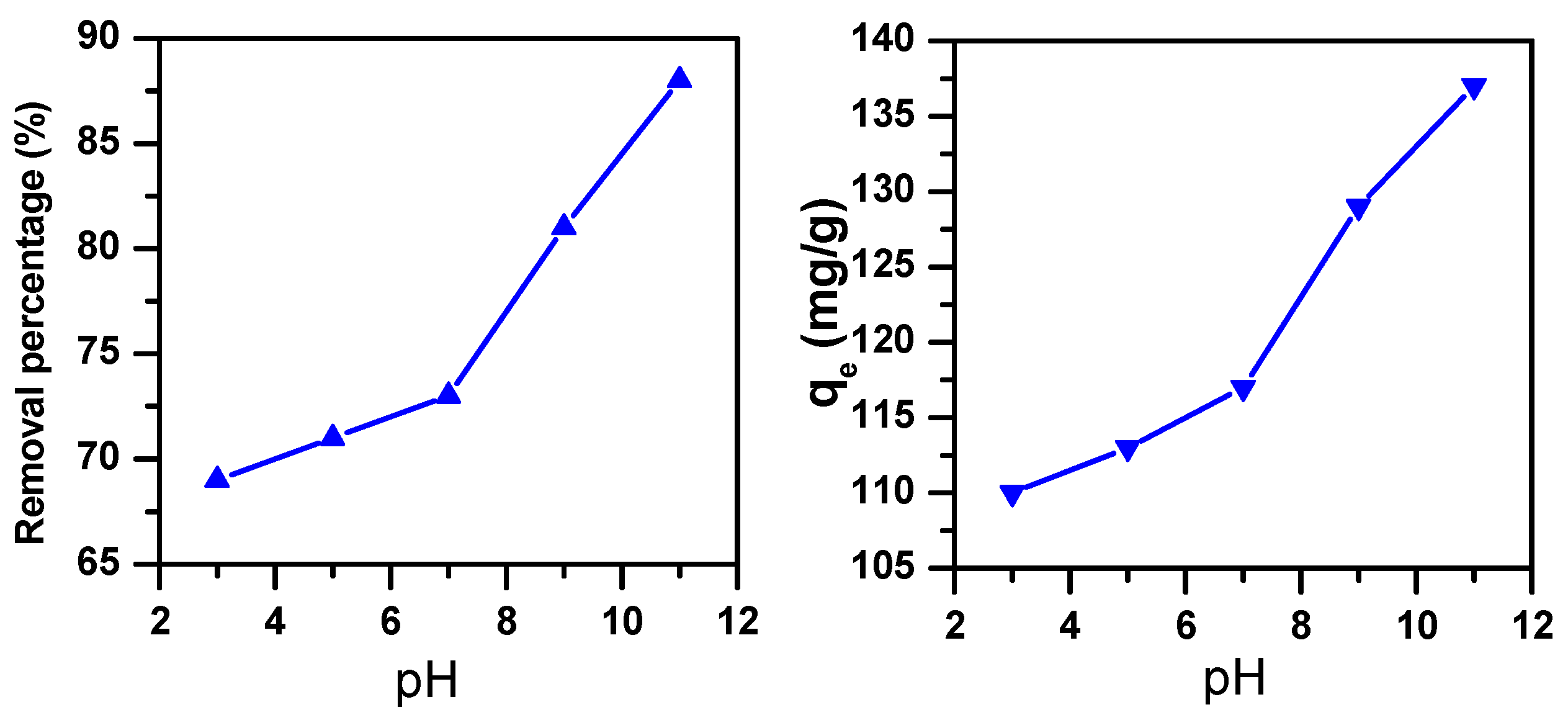

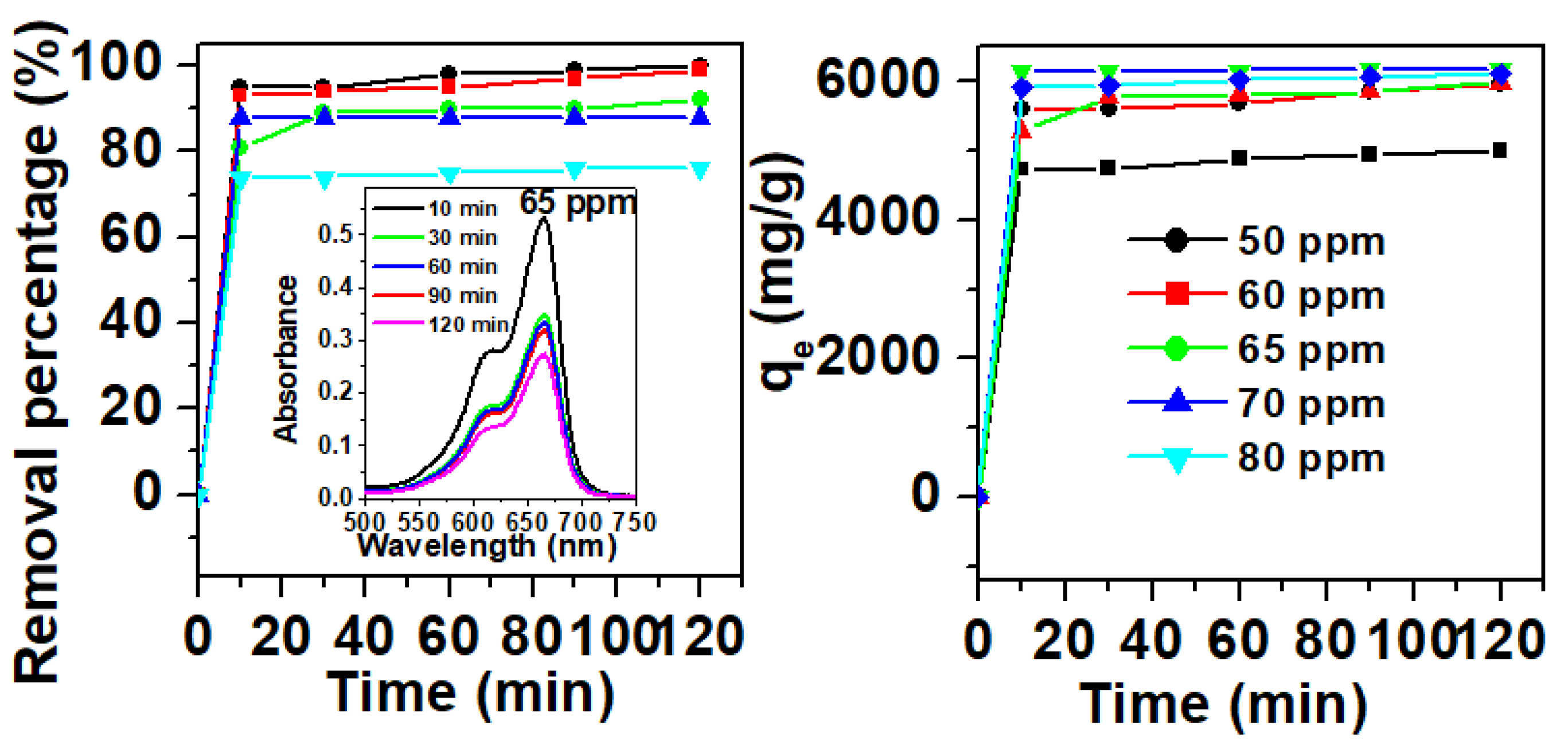
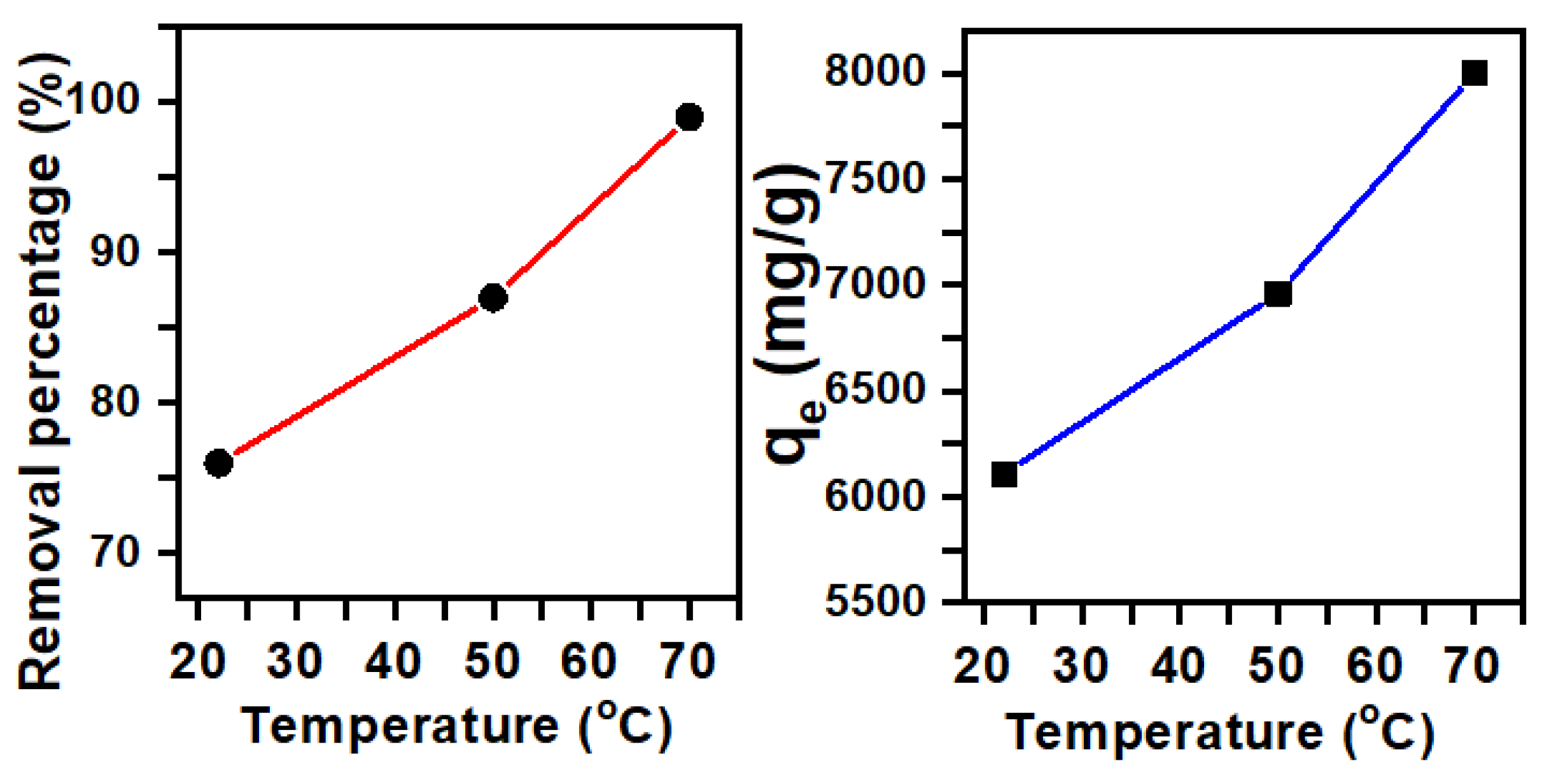
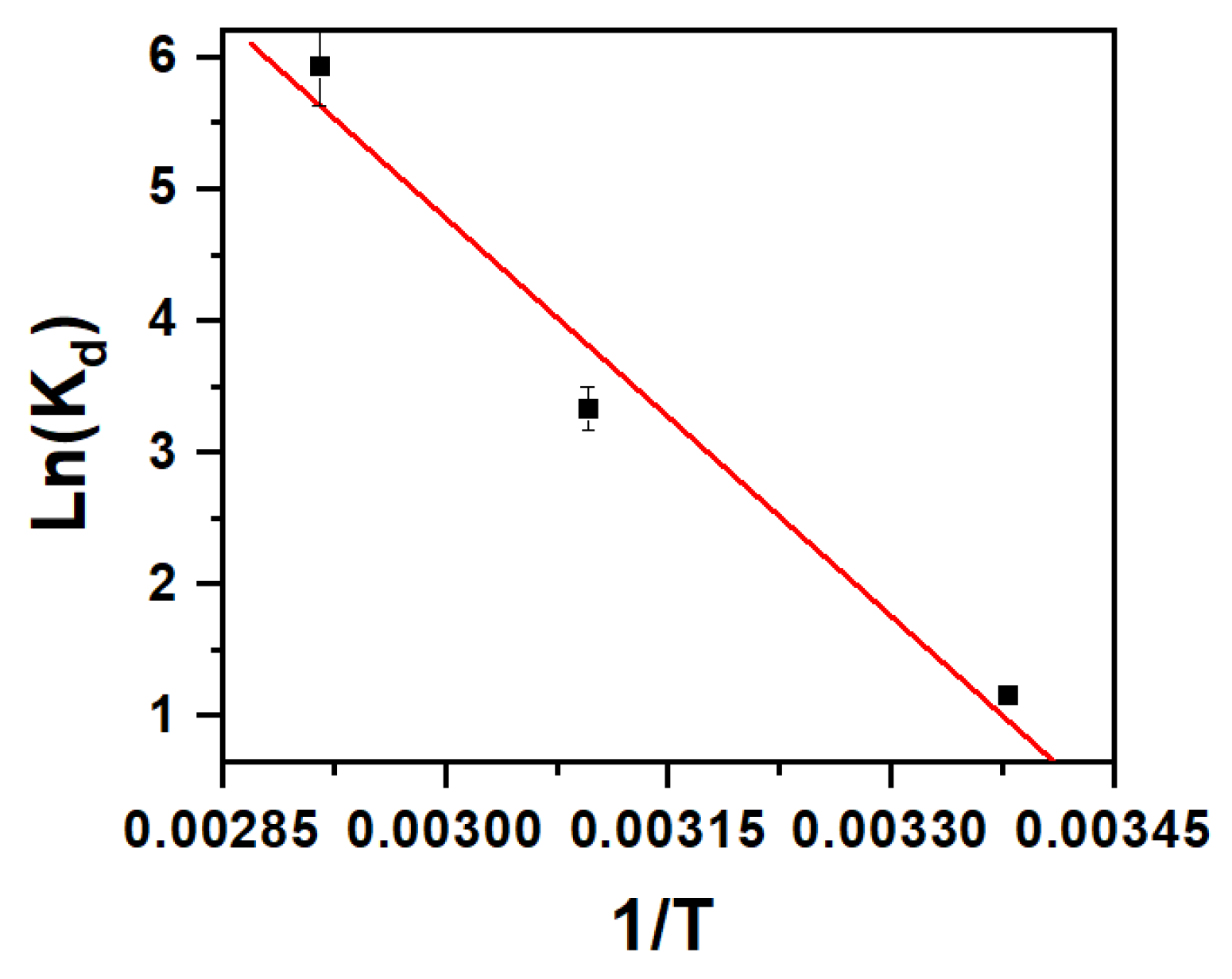
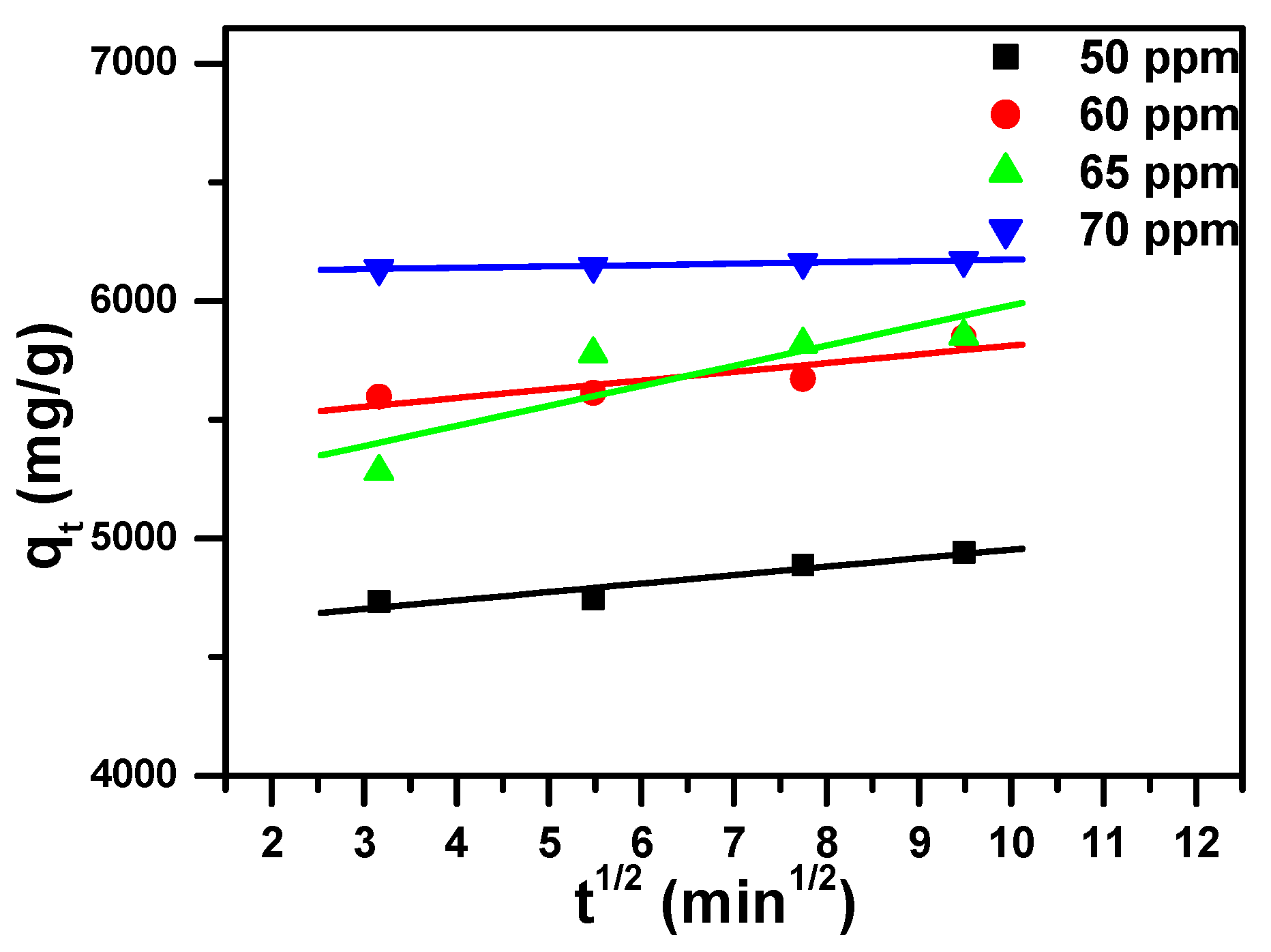

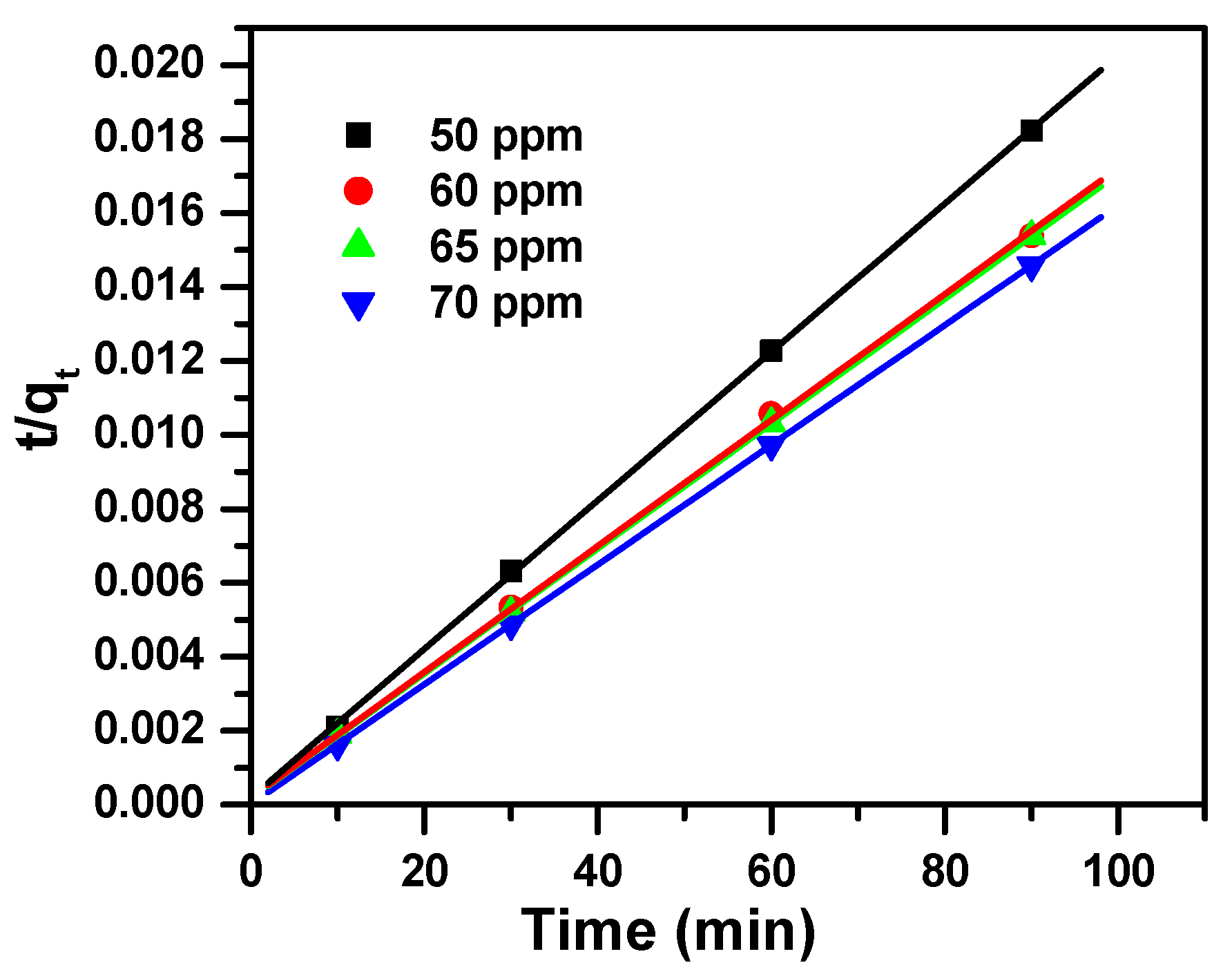
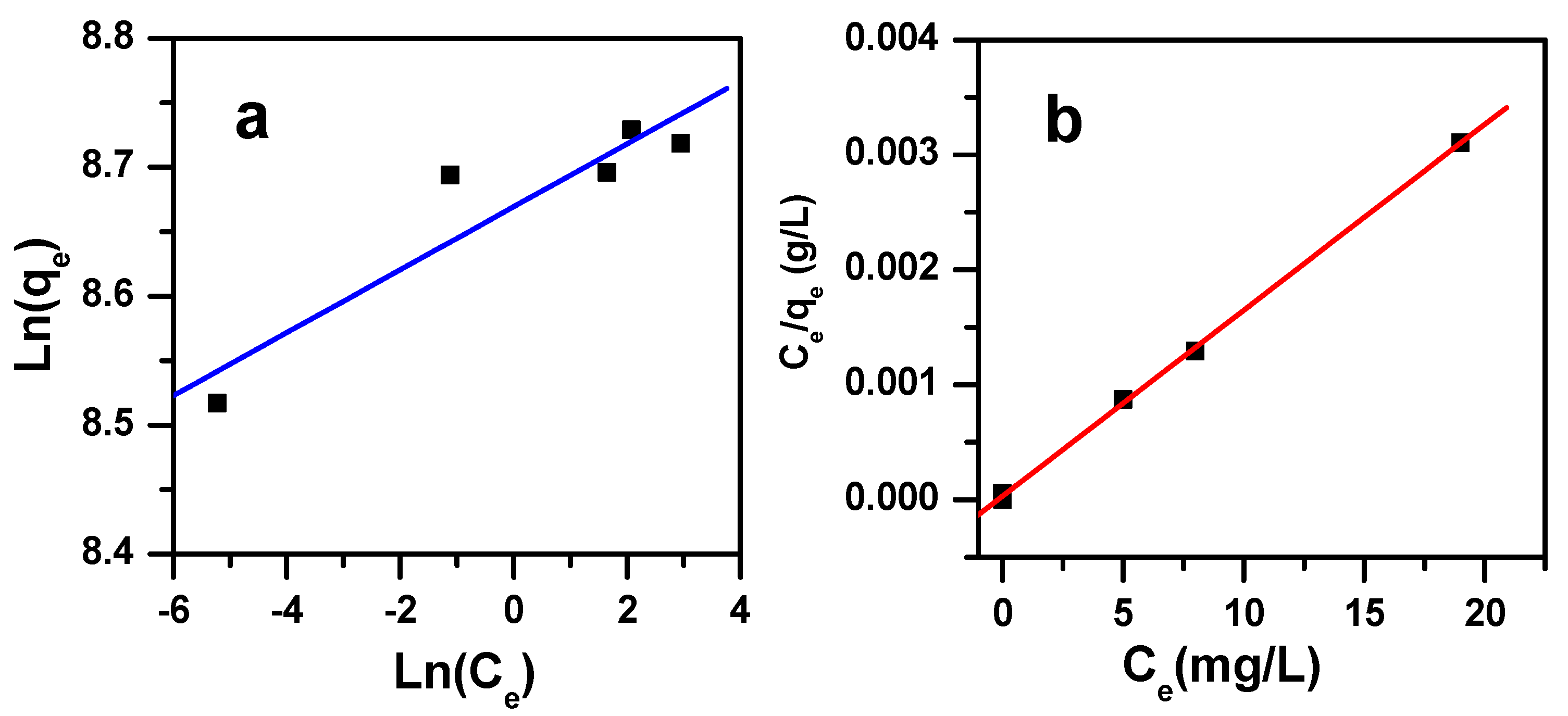

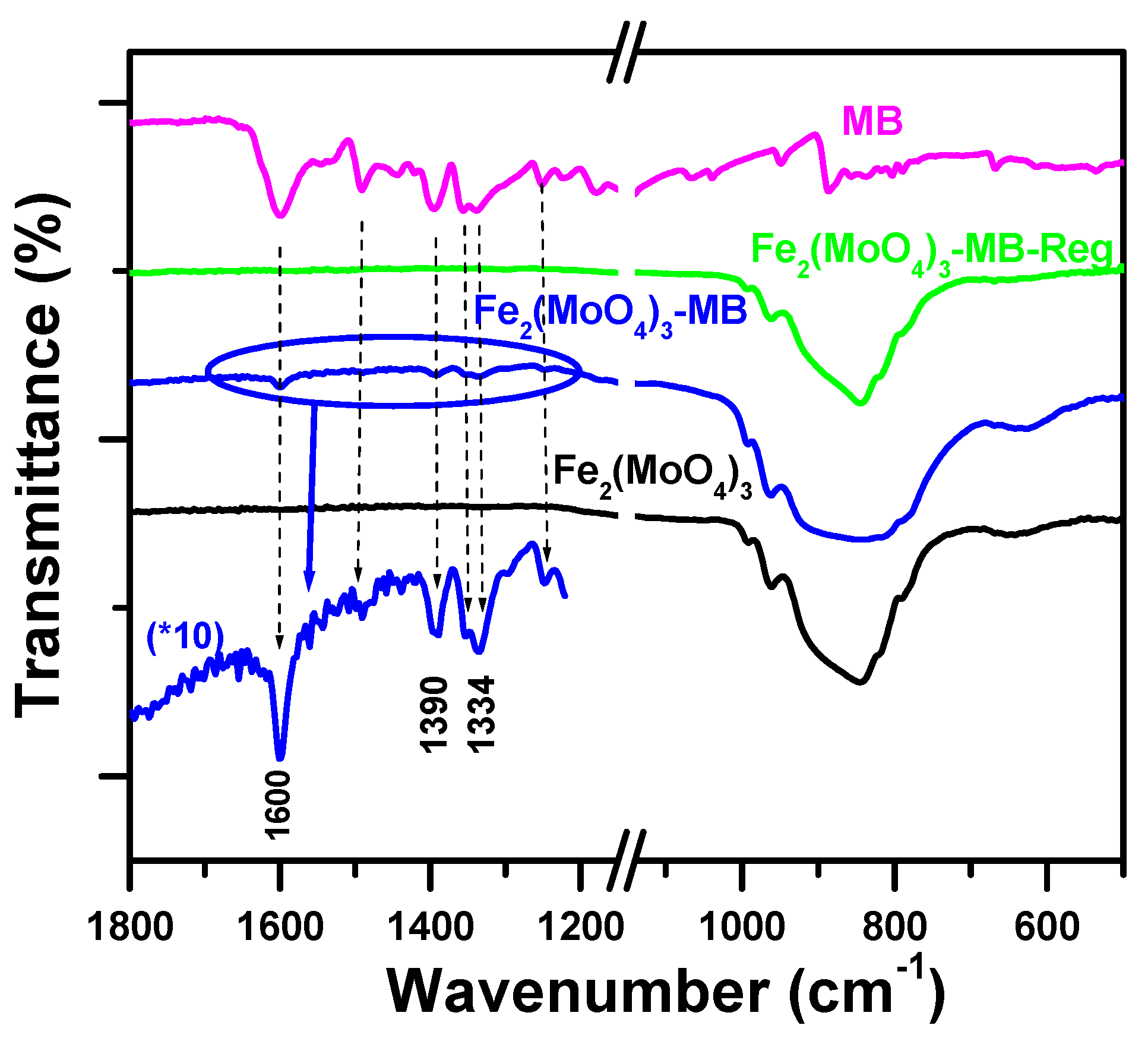
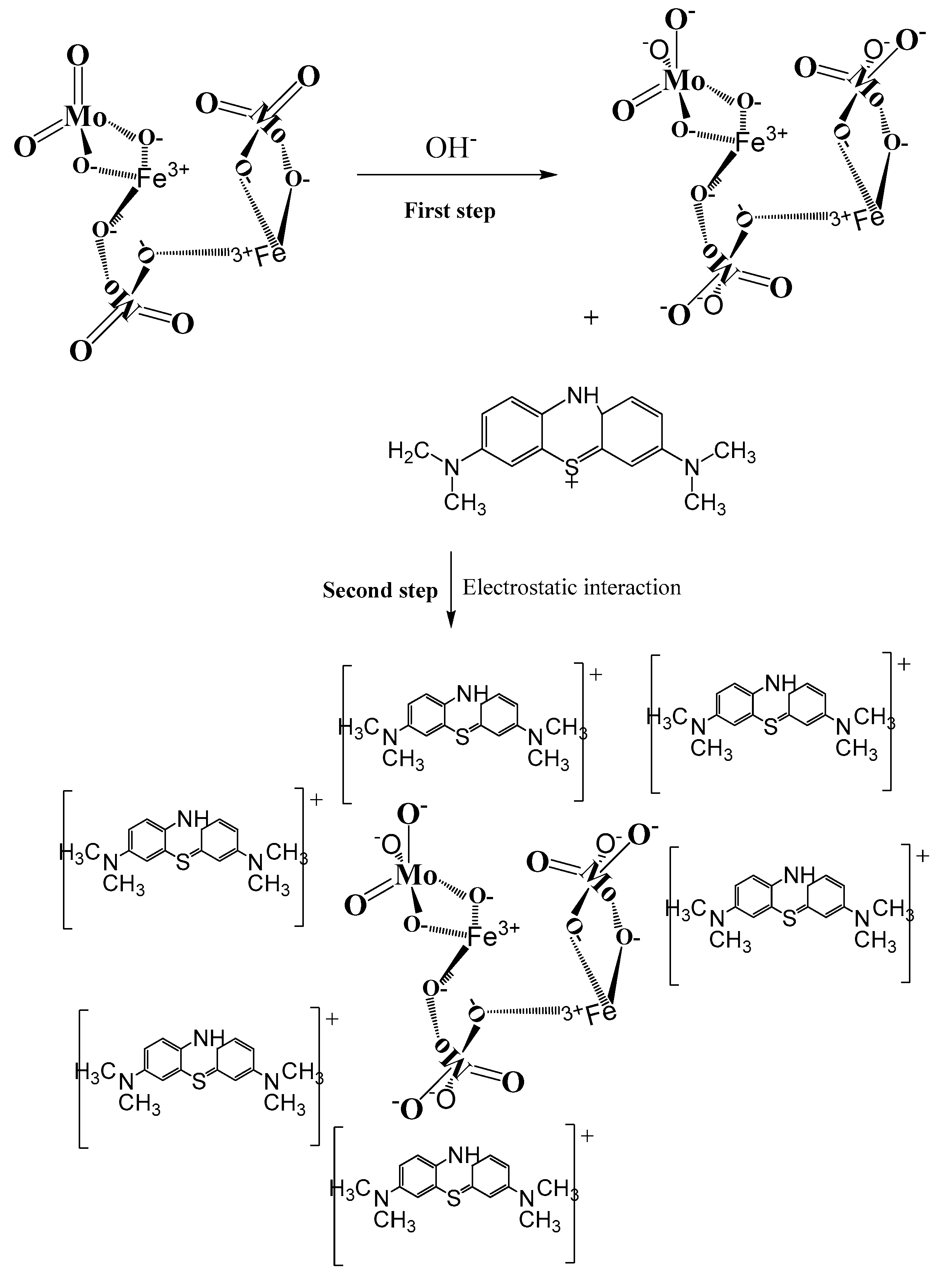
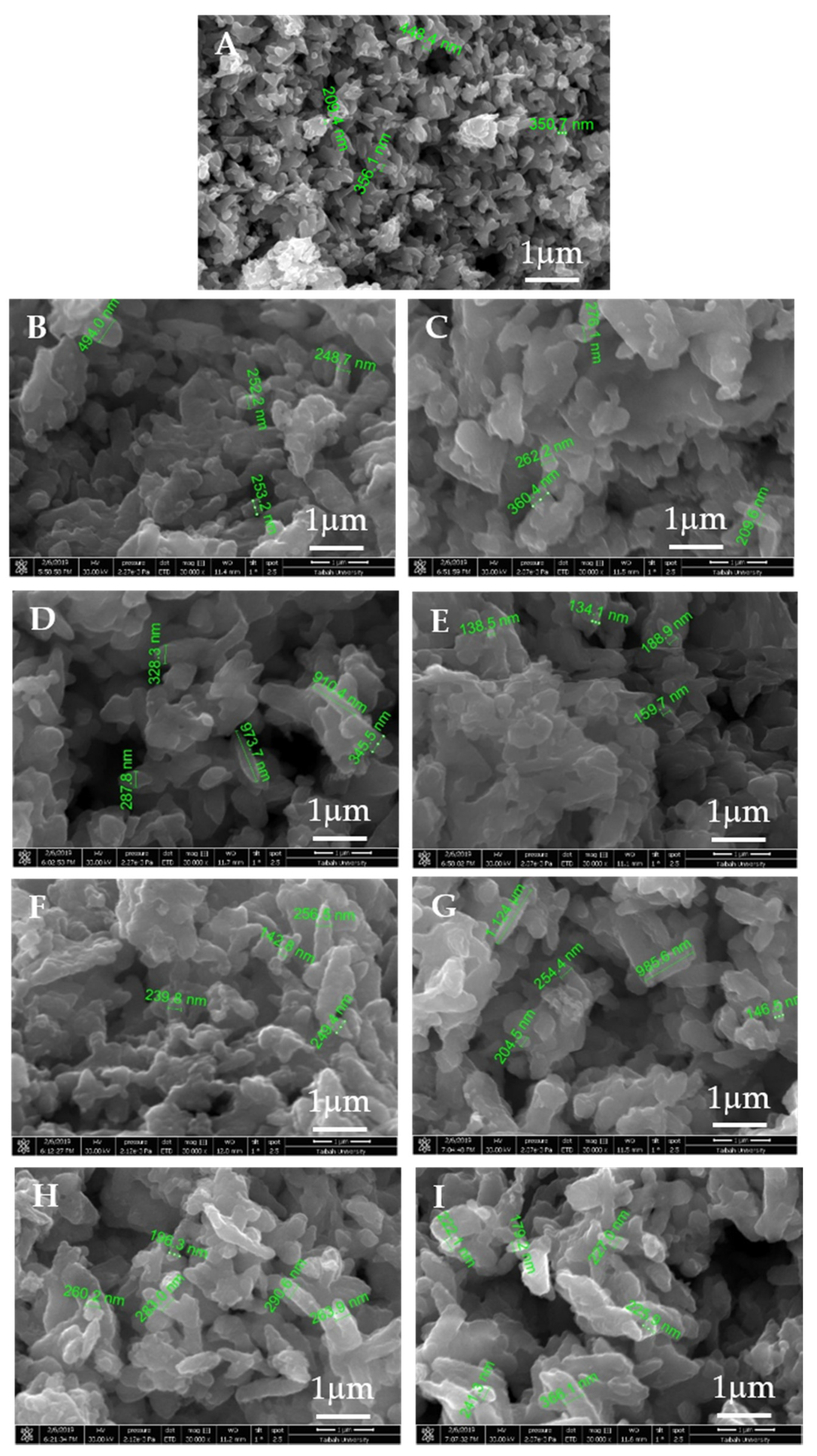
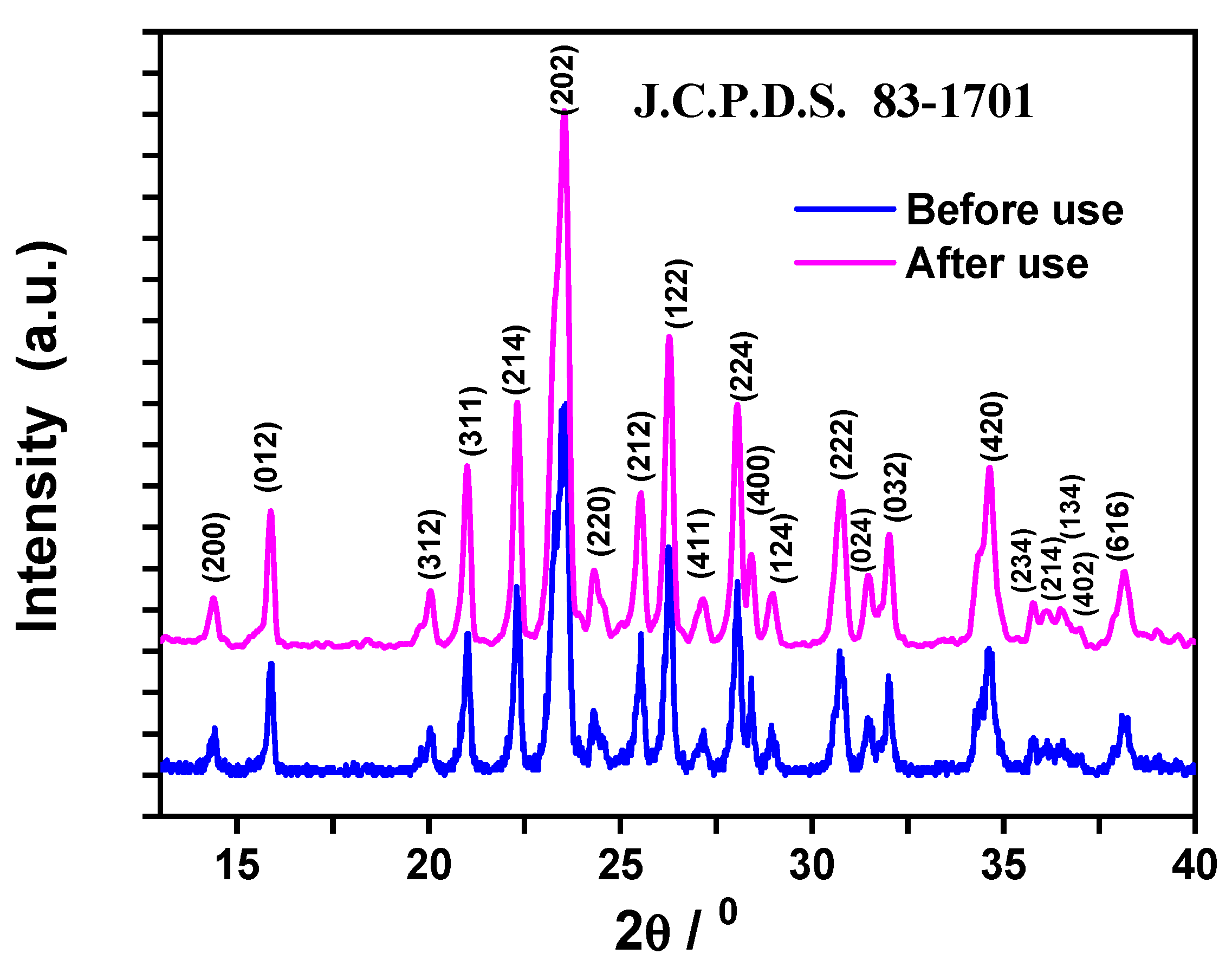
| Adsorbent | Adsorbate | ∆H° (KJ·mol−1) | ∆S° (KJ·mol−1·K) | ∆G° (KJ·mol−1) | ||
|---|---|---|---|---|---|---|
| Fe2(MoO4)3 | MB | 83.79 | 0.291 | 296K | 323K | 343K |
| −2.904 | −8.934 | −16.402 | ||||
| Model | Equation | Parameters |
|---|---|---|
| Pseudo-first-order (PFD) [50] | (4) | qt: the removal capacity at time t (mg/g) qe: the removal capacity at equilibrium (mg/g) K1: the rate constant of pseudo-first-order adsorption (1/min) |
| Pseudo-second-order (PSD) [50] | (5) | qt: the removal capacity at time t (mg/g) qe: the removal capacity at equilibrium (mg/g) K2: the pseudo-second-order rate constant (g. mg−1.min−1) |
| Intraparticle diffusion (IPD) [51] | (6) | I (mg/g) and KI (mg/(g.min0.5)) are the intraparticle diffusion constants qt: the removal capacity (mg/g) at time t t: the contact time (min) |
| Dye (Ci mg/L) | Pseudo-First-Order | Pseudo-Second-Order | Intraparticle Diffusion Model | |||||||
|---|---|---|---|---|---|---|---|---|---|---|
| qexp (mg/g) | qe (mg/g) | k1 (1/min) | R12 | qe (mg/g) | k2 (g/mg min) | R22 | I (mg/g) | ki (mg/g min0.5) | R32 | |
| 50 | 4999 | 378 | 0.020 | 0.956 | 4981 | 0.00021 | 1.000 | 4596 | 36 | 0.904 |
| 60 | 5967 | 496 | 0.014 | 0.814 | 5871 | 0.00016 | 0.999 | 5444 | 37 | 0.782 |
| 65 | 5979 | 565 | 0.019 | 0.752 | 5922 | 0.00016 | 1.000 | 5135 | 85 | 0.748 |
| 70 | 6179 | 57 | 0.021 | 0.993 | 6176 | 0.00154 | 1.000 | 6117 | 6 | 0.993 |
| Model | Equation | Parameters |
|---|---|---|
| Freundlich [52] | (7) | qF: Freundlich constant (mg(1−1/n)L1/ng−1) n: heterogeneity factor (g/L) qe: amount of MB dye adsorbed by α-Fe2(MoO4)3 at equilibrium (mg/g) Ce: MB concentration at equilibrium (ppm) |
| Langmuir [52] | (8) | qe: amount of MB dye adsorbed by α-Fe2(MoO4)3 at equilibrium (mg/g) Ce: MB concentration at equilibrium (ppm) qm: maximum amount of MB dye removed by Fe2(MoO4)3 (mg/g) KL: Langmuir adsorption constant (L/mg) |
| (9) | Ci: initial concentration of MB KL: Langmuir constant RL: values specify that the removal of MB dye could be linear (RL = 1), irreversible (RL = 0), favorable (0 < RL < 1) or unfavorable (RL > 1) | |
| Dubinin-Radushkevich (D-R) [53] | (10) (11) | K: sorption energy constant (mol2/kJ2) ε: Polanyi potential T: temperature (K) R: universal gas constant (8.314 J.mol−1 K−1) qm: theoretical saturation capacity Ce: MB concentration at equilibrium (ppm) |
| Temkin [54] | (12) | bT: Temkin constant related to heat of sorption (J/mol), BT = RT/bT R: gas constant (8.314 J/mol K) AT: Temkin isotherm constant (L/g) T: absolute temperature (K) |
| Langmuir | Freundlich | Temkin | Dubinin-Radushkevich | |||||||||
|---|---|---|---|---|---|---|---|---|---|---|---|---|
| qm (mg/g) | KL (L/mg) | R2 | Range RL | qF (mg(1−1/n)L1/ng−1) | 1/n | R2 | AT (L/g) | BT | R2 | qm (mg/g) | R2 | E (Kj/mol) |
| 6173 | 5 | 0.999 | 0.0024–0.0038 | 5825 | 0.02 | 0.866 | 5E18 | 135 | 0.870 | 6063 | 0.971 | 944 |
| Nanosorbent | qm (mg/g) | Reference |
|---|---|---|
| Magnetic β-cyclodextrin-chitosan nanoparticles | 2783.30 | [55] |
| Fe2O3 | 1124.70 | [56] |
| Zinc molybdate nanoparticles | 217.86 | [23] |
| CoO | 5501.93 | [56] |
| Molybdenum trioxide nanorods and stacked nanoplates | 152.00 | [45] |
| Iron molybdate (Fe2(MoO4)3) | 6173.00 | This work |
Sample Availability: Samples of the compounds iron molybdate (Fe2(MoO4)3 are available from the authors. | |
Publisher’s Note: MDPI stays neutral with regard to jurisdictional claims in published maps and institutional affiliations. |
© 2020 by the authors. Licensee MDPI, Basel, Switzerland. This article is an open access article distributed under the terms and conditions of the Creative Commons Attribution (CC BY) license (http://creativecommons.org/licenses/by/4.0/).
Share and Cite
Mohmoud, A.; Rakass, S.; Oudghiri Hassani, H.; Kooli, F.; Abboudi, M.; Ben Aoun, S. Iron Molybdate Fe2(MoO4)3 Nanoparticles: Efficient Sorbent for Methylene Blue Dye Removal from Aqueous Solutions. Molecules 2020, 25, 5100. https://doi.org/10.3390/molecules25215100
Mohmoud A, Rakass S, Oudghiri Hassani H, Kooli F, Abboudi M, Ben Aoun S. Iron Molybdate Fe2(MoO4)3 Nanoparticles: Efficient Sorbent for Methylene Blue Dye Removal from Aqueous Solutions. Molecules. 2020; 25(21):5100. https://doi.org/10.3390/molecules25215100
Chicago/Turabian StyleMohmoud, Ahmed, Souad Rakass, Hicham Oudghiri Hassani, Fethi Kooli, Mostafa Abboudi, and Sami Ben Aoun. 2020. "Iron Molybdate Fe2(MoO4)3 Nanoparticles: Efficient Sorbent for Methylene Blue Dye Removal from Aqueous Solutions" Molecules 25, no. 21: 5100. https://doi.org/10.3390/molecules25215100
APA StyleMohmoud, A., Rakass, S., Oudghiri Hassani, H., Kooli, F., Abboudi, M., & Ben Aoun, S. (2020). Iron Molybdate Fe2(MoO4)3 Nanoparticles: Efficient Sorbent for Methylene Blue Dye Removal from Aqueous Solutions. Molecules, 25(21), 5100. https://doi.org/10.3390/molecules25215100







